The next wave of prospective students is already taking shape: Generation Alpha, born between 2010 and 2024. They’re poised to become the most digitally fluent, diverse, and tech-immersed generation in history, raised on smartphones, voice assistants, and AI from day one. By 2028, the first Gen Alpha freshmen will be setting foot on college campuses, bringing entirely new expectations for how learning happens and how schools communicate their value.
Here’s the thing: education marketers can’t afford to wait. Gen Alpha’s habits and motivations differ sharply from Millennials or even Gen Z. In this article, we’ll unpack who Gen Alpha is, what drives their choices, and why institutions must start adapting their recruitment strategies now.
Drawing on Higher Education Marketing (HEM)’s latest research and webinar insights, we’ll introduce our recommended “PAC” framework, Platform, Algorithm, Culture, a model designed to help schools reach Gen Alpha effectively. We’ll also explore strategies like dual-audience messaging (targeting both students and their Millennial parents), along with content tactics centered on authenticity, user-generated content (UGC), answer-first communication, and AI-ready web experiences.
These ideas will be grounded in real-world examples, from universities using Roblox campus tours to schools experimenting with Snapchat AR lenses, and illustrated through HEM client success stories across K–12, language, and higher education sectors.
By the end, you’ll have a clear roadmap to engage both Gen Alpha and their parents through an integrated approach that connects CRM lead nurturing, SEO, social media, and multilingual content into a cohesive next-gen recruitment strategy.
Let’s dig into what makes Generation Alpha unique and how your institution can get ready now.
Who Is Generation Alpha?
Generation Alpha refers to children born between 2010 and 2024. They are the first cohort raised entirely in the 21st century, often called the first true digital natives.
From iPads in the crib to AI assistants in the living room, Gen Alpha has never known life without touchscreens or high-speed internet. Many learned to navigate apps and streaming platforms before they could read, making technology an effortless part of everyday life.
Early experiences with remote and hybrid learning have also shaped them. Even in primary school, they joined online video classes, used learning apps, and explored online games, giving them a comfort with digital learning that feels natural.
Raised largely by Millennial parents, Gen Alpha is globally minded and culturally diverse. They are aware of issues like climate change and social justice, value inclusivity, and seek purpose in education.
Their aspirations are high, and so are their expectations. They and their parents will assess the return on investment of higher education carefully. College decisions will be shared within the family, meaning recruitment messages must appeal to both the student and the parent.
Gen Alpha’s Behavior, Media Use, and Decision Drivers
To connect with Generation Alpha, institutions need to meet them on their terms. Let’s look at how they interact with media, information, and the factors shaping their decisions.
- Authenticity Over Polish
Gen Alpha can spot inauthenticity a mile away. Surrounded by social media from birth, they value honesty over gloss. Highly produced marketing materials feel distant to them; real voices earn trust. Peer content matters more than official content, and a student’s testimonial filmed on a phone will often outperform a polished promo video. Schools that feature current students or young alumni as micro-influencers tend to resonate most. A student-led TikTok dorm tour, for instance, can do more to inspire confidence than a scripted campus video.
- Short-Form Video and Shared Screens
Raised on YouTube and TikTok, Gen Alpha consumes information in quick bursts. They use short-form videos to learn, discover, and be entertained. Yet, they also share viewing time with family, watching longer videos together on smart TVs. This dual habit creates an opportunity for schools to publish family-friendly content on YouTube while using TikTok or Instagram Reels for short, high-impact storytelling.
- Social Means Conversational and Interactive
Gen Alpha doesn’t just scroll; they participate. They use Snapchat for authentic chats and AR filters for creative expression. Gaming worlds such as Roblox and Minecraft double as social spaces where they collaborate and build together. This generation expects to engage, not just observe. Recruitment content should invite participation through polls, challenges, or interactive Q&As rather than simply broadcasting messages.
- Digital-Native, but Still Campus-Curious
Although they are digital natives, Gen Alpha still craves real-world experiences. Campus visits remain important, but they expect them to be hands-on and immersive. They want to test a lab, attend a mini class, or pilot a drone. For them, visiting campus feels like trying on an experience to see if it fits. Schools should design events that blend physical and virtual engagement to appeal to this tactile curiosity. - Instant Answers and Micro-Decisions
This generation grew up with instant search and voice assistants. They want quick, direct answers, not lengthy explanations. They prefer content structured as questions and answers, such as “What scholarships does this college offer?” followed by a concise response. This approach supports both their research style and the shift toward AI-driven search engines that prioritize clear, digestible information. - Values-Driven and Proof-Oriented
Gen Alpha deeply cares about social impact. Issues such as sustainability, inclusion, and mental health influence their decisions. However, they don’t take claims at face value. They expect evidence through authentic stories, real programs, and visible results. Institutions that demonstrate genuine action, rather than marketing slogans, will earn their trust.
Bottom line: Gen Alpha lives online but thinks critically. They move fast, multitask across screens, consult their parents, and expect authenticity at every turn. To earn their attention and trust, institutions must create marketing that is honest, interactive, and evidence-based.
Why Institutions Must Start Preparing Now
Why should institutions start preparing now? It might seem like there’s still time before Generation Alpha reaches college. The oldest are only about 15 or 16 today, but the time to prepare is now.
The Oldest Are Already in High School
Those born in 2010 are entering the college research phase alongside their Millennial parents. By 2028, they’ll be enrolling in universities. For K–12 private schools, Gen Alpha isn’t the future; they’re your current students. Enrollment strategies, open houses, and outreach events already need to align with their digital-first expectations.
Strategy Shifts Take Time
Building authentic social channels, redesigning content ecosystems, and integrating CRM workflows can’t happen overnight. Starting now means time to test and refine. Schools experimenting with TikTok, YouTube Shorts, or AI-powered content today will lead the field when Gen Alpha applications surge.
Gen Z Is the Bridge
Current college students have already pushed institutions to modernize through video storytelling and social media. Those adaptations laid the groundwork. Now, Gen Alpha’s shorter attention spans and AI fluency require schools to go further. If you’ve successfully reached Gen Z, you’re ahead. If not, there’s catching up to do.
Early Adopters Will Stand Out
Institutions that embrace next-gen tactics, from interactive chat tools to UGC-driven campaigns and dynamic FAQ hubs, will gain a visible edge. These schools appear more innovative and student-centered to both teens and parents.
Parent Expectations Are Rising Too
Millennial parents expect quick, personalized communication. Text alerts, Instagram Live Q&As, and ROI-focused content all resonate. Preparing now allows you to fine-tune messaging for both audiences: students and parents.
In short, every admissions cycle will include more Gen Alpha students. The strategies that worked for Millennials and Gen Z must evolve now, and Higher Education Marketing (HEM) is ready to help institutions future-proof recruitment.
HEM’s Next-Gen Recruitment Strategies: The PAC Framework and Beyond
At Higher Education Marketing (HEM), our research into Generation Alpha’s habits has led to the development of the PAC Framework, short for Platform, Algorithm, Culture. This model helps institutions design content and campaigns that genuinely connect with Gen Alpha and get noticed in today’s media environment. Around PAC, we integrate complementary tactics such as dual-audience messaging, authenticity systems, answer-first content, immersive campus experiences, and AI search optimization.
1. Platform: Go Where Gen Alpha Is
It sounds simple, yet many institutions still miss this step. “Platform” means existing where Gen Alpha spends their time, on platforms like TikTok, YouTube, Snapchat, or even Roblox. Don’t just create accounts; learn how each ecosystem works. What’s trending? What humor or language feels native? Explore these platforms like a student would. Then decide how your institution should engage, through creator collaborations, banner placements, or sponsored events. The key is to meet students where they are, not where you’re comfortable.
Example: Florida International University (USA): FIU has adopted TikTok to connect with Gen Alpha, where they spend their time. FIU’s social team went viral by leveraging a trending audio challenge on TikTok aimed at students hoping to excel on their midterms. The result was a TikTok that garnered over 10 million views and 1.46 million engagements, demonstrating how being present on Gen Alpha’s favorite platforms can massively boost reach.

Source: TikTok
2. Algorithm: Design for Distribution
Algorithms decide who sees your content. Success depends on understanding how each platform’s system rewards engagement. On TikTok, videos with high watch time and early comments rise quickly. On Google, structured Q&A pages and strong metadata perform best. Research shows attention spans among younger audiences now average two to three seconds. Lead with a hook, such as a bold question, emotion, or relatable visual. Keep captions tight and content shareable. Treat the algorithm like a person you need to impress fast.
Example: Colorado State University (USA): CSU has strategically designed content to please each platform’s algorithm and grab attention within seconds. Seeing the rise of TikTok’s algorithm-driven “For You” feed, CSU shifted heavily to short-form vertical video and front-loaded content with hooks. The social team launched an official TikTok in 2022 with a “non-manicured” approach: four student creators post 4–5 raw, authentic videos per week. This consistency and emphasis on trending audios and quick, relatable hooks led to about 130,000 video views and 12,000 engagements per month on CSU’s TikTok. By tailoring content format (e.g., snappy cuts, engaging captions) to each platform’s algorithmic preferences, CSU ensures its posts get maximum distribution in Gen Alpha’s feeds.
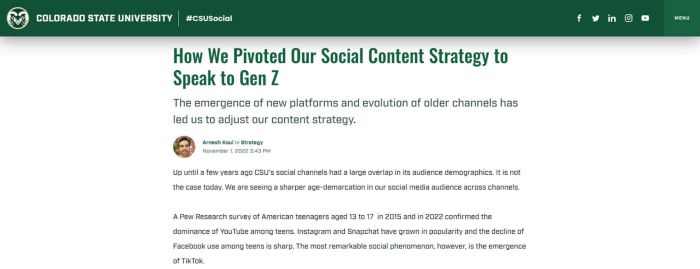
Source: Colorado State University
3. Culture: Co-Create and Stay Current
Culture is where authentic connection happens. Gen Alpha responds to real voices, humor, and values. Collaborate with students to produce takeovers, TikToks, or short vlogs. Reflect diversity and align with current conversations. Join cultural moments carefully, whether that’s referencing a popular meme or spotlighting sustainability initiatives. Imperfection, such as a slightly unpolished student video, signals truth and authenticity.
As HEM puts it, algorithms get you seen, but culture gets you remembered. Using PAC as a creative checklist ensures your marketing is visible, relevant, and real.
2. Craft Dual-Audience Messaging (Students + Parents)
Because Generation Alpha’s education decisions will be co-driven by their Millennial parents, Gen Alpha student recruitment messaging must speak to both audiences at once. HEM’s approach, dual-audience messaging, ensures every touchpoint, from websites to ads, connects with both teens and parents in harmony.
For Students
Gen Alpha students care about community, creativity, and experience. They’re asking, “Will I fit in? Will this be exciting?” Highlight student life, clubs, and hands-on learning opportunities through visuals and peer perspectives. Use quotes or short video clips from current students discussing campus life or real projects. Peer voice matters more than institutional formality; a student testimonial will always carry more weight than a dean’s welcome.
For Parents
Millennial parents want reassurance. Their questions are about safety, credibility, and ROI. Showcase graduation rates, career outcomes, accreditation, and alumni success stories. Include details on support services, mental health resources, and campus security. Demonstrating both value and care builds confidence.
How to Integrate Both
Every major recruitment asset should serve both audiences. You can segment sections (“For Students” vs. “For Parents”) or blend them seamlessly. For instance, a video might open with student testimonials, transition into outcomes and parental perspectives, and end with a message that resonates with both.
Action Step: Audit your current materials for balance. Ensure students feel inspired and parents feel assured.
Example: Queen Anne’s School (UK): This independent girls’ school in England structures every recruitment touchpoint to speak to both Gen Alpha students and their millennial parents in tandem. For example, Queen Anne’s hosts Open Mornings that explicitly cater to “you and your daughter.” During these events, girls sample classes and campus life (answering the student’s “Will I have fun and fit in?”), while parents tour facilities and hear the Head’s vision for the school (addressing the parents’ concerns about values and outcomes). The school offers a wide range of visit options – from personal family tours to student “taster days” where 11–13 year olds spend a day on campus – ensuring both audiences are engaged.
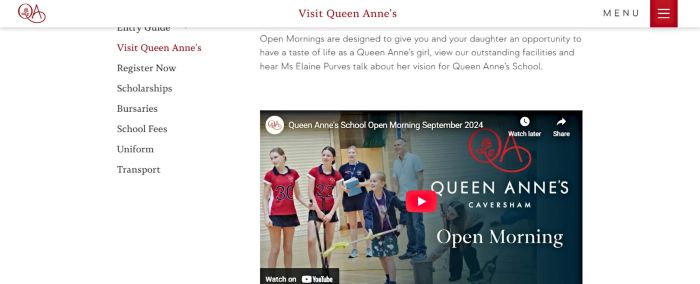
Source: Queen Anne’s School
3. Establish an “Authenticity System” (UGC and Influencers)
For Generation Alpha, authenticity is the ultimate trust signal. To deliver it consistently, HEM recommends building an Authenticity System, a structured process that continuously produces genuine, student-driven content.
User-Generated Content (UGC) Cadence
Plan for a steady flow of unpolished, real moments. Repost student photos or short TikToks weekly to show campus life through their eyes. Campaigns like #MyCampusMondays, where students share everyday snapshots, keep your content authentic and current. The goal is to make sure that whenever a Gen Alpha prospect visits your social channels, they see real students, not PR gloss.
Student Ambassadors and Creators
Empower students to take part in marketing. Invite ambassadors or micro-influencers to run Instagram takeovers, film vlogs, or stream events. These voices carry credibility because they feel peer-to-peer, not top-down. As HEM research shows, student creators can dramatically increase engagement by making your institution feel accessible and alive.
Authentic Voice and Visuals
Encourage content that sounds natural and looks real. A video filmed on a phone, with casual language or inside jokes, often performs better than a polished shoot. Include candid photos or unscripted clips, authenticity over perfection every time.
Integrate Authentic Content Across Channels
Don’t let UGC live in isolation. Embed student testimonials, quote cards, or video clips directly on program or FAQ pages. Pairing factual info with real student stories creates a persuasive one-two punch.
In short, authenticity shouldn’t happen by accident, it should already be built into your system.
Example: Colorado State University (USA): CSU has built a systematic pipeline for authentic, student-driven content. After officially launching its TikTok, CSU deliberately adopted a “raw” content style – no slick ads, just students with smartphones. It set up a core group of student content creators who post unfiltered clips multiple times a week, giving a continuous stream of real campus moments. In addition, CSU regularly reposts user-generated content from students: from dorm room mini-blogs to everyday campus snapshots. Every week, prospective Gen Alpha students checking CSU’s socials will see new posts by their peers, not just the PR team. By baking student UGC into the content calendar, CSU continuously projects an honest, peer-to-peer voice that Gen Alpha trusts.
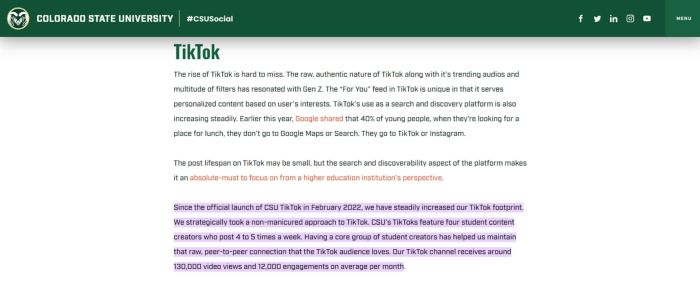
Source: Colorado State University
4. Embrace Answer-First Content and AI Search Readiness
Generation Alpha searches differently. They ask full questions and expect immediate, concise answers. To connect with them and perform well in AI-driven search, schools need an answer-first content strategy.
Build Q&A Hubs
Create web pages organized by questions and answers, not long paragraphs. For example:
- What hands-on experiences will I get in the Nursing program?
- What are the career outcomes for graduates?
This structure helps both humans and AI bots find what they need quickly. HEM calls these “answer-first hubs,” expanded FAQ-style pages covering dozens of micro-questions. Use data from inquiries and chats to identify what prospects ask most often.
Add Video and Micro-Content
Gen Alpha prefers short, visual responses. Embed 30–60 second video answers from students or staff directly on your pages. A student selfie explaining “What’s the first-year experience like?” feels more authentic than text alone. For parents, include short clips addressing safety or support topics. Repurpose each Q&A across platforms like YouTube Shorts or Reddit for added reach.
Implement Structured Data
Make content machine-readable. Adding FAQ schema markup tells Google and AI assistants what each Q&A covers, improving visibility in featured snippets and AI chat results. HEM research shows this can increase AI-driven visibility by up to 30%.
Write for Voice and Natural Language
Use conversational phrasing such as “How do I apply for financial aid?” instead of standard titles. Ensure each answer short but complete, ideal for AI summaries or voice assistants. Schools already applying this approach have seen measurable boosts in organic traffic and “People Also Ask” placements.
Bottom line: think like an answer engine. Gen Alpha asks questions, so make sure your content answers first.
Example: Cumberland University (USA): Cumberland makes information instantly accessible by structuring its admissions content around questions and direct answers. Its website features a comprehensive Admission FAQs hub that compiles “our most frequently asked questions to help you find the answers you need quickly”. Prospective students and parents can click categories like Undergraduate, Graduate, International, etc., and find dozens of bite-sized Q&As (e.g., “What are the application requirements?”, “Is there housing for freshmen?”). Each answer is concise and written in plain language – perfect for Gen Alpha’s tendency to ask full questions in Google or AI assistants. By adopting this answer-first approach (instead of burying info in long paragraphs), Cumberland not only improves user experience but also boosts its visibility on search engines. Many of its FAQ entries use structured data markup, so they often appear as featured snippets or “People Also Ask” results on Google.
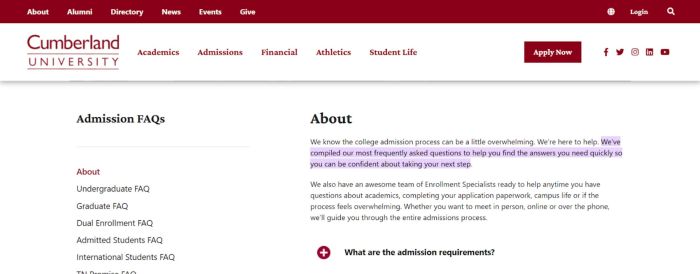
Source: Cumberland University
5. Treat Your Campus as a Product: Demos and Immersive Experiences
For Generation Alpha, choosing a school feels like choosing a lifestyle brand. They want to experience it before committing. That’s why HEM recommends marketing your campus like a product demo, through in-person and virtual experiences that let students and parents “test-drive” what you offer.
Creator-Hosted Events
Make campus events hybrid and interactive. Invite student creators to livestream open houses or campus days on TikTok, YouTube, or Instagram Live. A student host with a GoPro or phone camera gives the experience authenticity and energy. Let online viewers ask questions in real time while seeing dorms, labs, or the dining hall rush. It’s immersive, engaging, and feels like hanging out with a trusted peer.
Hands-On Campus Trials
When prospects visit in person, let them participate. Replace passive tours with interactive demos, mini labs, culinary workshops, or creative challenges. Some schools have gamified tours, turning them into scavenger hunts or student-led challenges. Participation builds emotional connection and makes visits memorable.
Augmented Reality (AR) and Virtual Worlds
Add AR filters or lenses during events to blend play with information. Imagine scanning a building to reveal fun facts or seeing your mascot in AR. Schools like Kent State University have used Snapchat AR lenses to boost engagement while lowering recruitment costs.
Take it further by creating virtual campuses in platforms like Roblox or Minecraft. Students can explore, play, and imagine life at your school long before applying.
Use Existing Tools
360° tours and virtual events on platforms like YouVisit or CampusTours make immersion easy.
The goal is to let Gen Alpha see themselves on campus. When they can explore, touch, and interact, even virtually, they’re far more likely to enroll.
Examples: Kent State turned its campus into an interactive product demo via augmented reality on Snapchat. In a pioneering campaign (the first of its kind in higher ed), Kent State built a custom AR lens that let prospective students virtually “try on” a piece of the college experience – in this case, placing a Kent State graduation cap on their heads, tassel and all. Users could move and see the tassel shake, and with one tap, were prompted to “apply to the university” right from Snapchat. This immersive lens was deployed to Snapchatters aged 16–18 in Kent State’s key recruiting regions. The results were astounding: engagement soared, and the AR campaign achieved a cost-per-application 24% lower than the university’s goal.
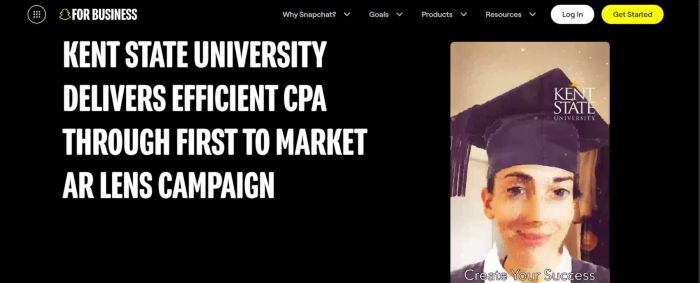
Source: Snapchat
University of Sussex (UK): At Sussex, students themselves have helped create a virtual campus that anyone can explore – effectively offering a perpetual, gamified open house. In 2024, a Sussex Computer Science student led a project to recreate the entire university campus in Minecraft, block by block. Using satellite data, the team imported ~1.4 km² of campus into the game (over 19 million blocks), achieving a 1:1 scale replica of Sussex’s buildings and grounds. Now, a group of 20+ students (and even alumni) is collaboratively adding interiors and details to bring it fully to life.
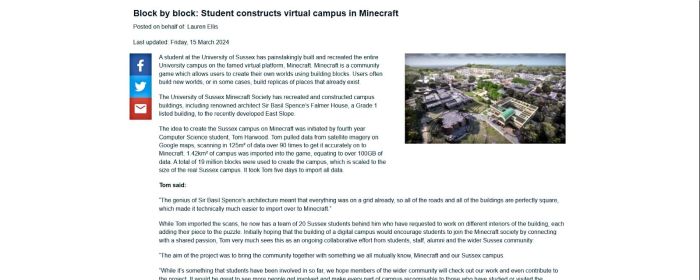
Source: University of Sussex
6. Integrate CRM, SEO, Social Campaigns, and Multilingual Content
Creating next-gen content for Generation Alpha is only half the battle. To convert attention into enrollment, schools need to align these tactics with the systems that power modern digital marketing. Here’s how HEM integrates CRM, SEO, social media, and multilingual strategy into a single recruitment engine.
CRM for Lead Nurturing
A robust education CRM is essential for tracking Gen Alpha inquiries and engaging them across multiple touchpoints—social DMs, event sign-ups, web forms, and more. Automated workflows can send personalized follow-ups instantly, such as a welcome video from a student ambassador or a link to a virtual Q&A. HEM often implements Mautic or HubSpot to manage this process. The result: faster responses, stronger engagement, and less manual work. Segment Gen Alpha students and their parents into complementary streams—student-life content for one, academic and ROI-focused messaging for the other.
Example: Michael Vincent Academy: Michael Vincent Academy, a private career school in Los Angeles, partnered with HEM to deploy a customized Mautic CRM for student recruitment. “It’s essential that we work smarter, not harder. The HEM Mautic CRM helps us do that,” said Tally B. Hajek, the academy’s CEO. HEM’s CRM solution automated key marketing workflows (such as follow-ups with prospective students) and provided reports to track lead progress and team activities. The system also included a lead-scoring mechanism to identify and prioritize high-value leads, ensuring staff focus on serious, good-fit applicants. As a result, core recruitment processes became automated, allowing the admissions team to spend more time building personal connections with prospects.

Source: Higher Education Marketing
SEO and Content Clusters
All that great content needs visibility. Use SEO to make it discoverable through optimized site structure, keyword strategy, and internal linking. Develop content clusters, interconnected pages and blogs built around key topics, to boost authority. HEM’s SEO overhauls have helped clients like Cumberland College achieve double-digit growth in organic traffic. Technical SEO, schema markup, and fast mobile performance are nonnegotiable for Gen Alpha’s on-demand expectations.
Social Media Campaigns
Meet Gen Alpha where they live: TikTok, YouTube, Snapchat, and Instagram. Blend organic storytelling with paid targeting. Use TikTok Spark Ads or Snapchat placements to amplify authentic student content that already performs well. Combine this with parent-focused Facebook and Google campaigns for a full-funnel strategy. HEM’s campaign for Queen Anne’s School used this dual approach, improving conversion rates from inquiry to enrollment.
Multilingual and International Reach
Gen Alpha is global. Translate or localize key pages and ads to reach families in multiple languages. Include subtitles, translated summaries, and multilingual SEO to capture diverse search traffic. HEM’s work with Wilfrid Laurier University demonstrated that localized messaging in Portuguese and Spanish drove stronger ROI in international markets.
Integrating these elements (CRM, SEO, social, and multilingual content) creates a seamless ecosystem that attracts, nurtures, and converts Gen Alpha prospects efficiently. It’s how institutions move from generating attention to generating results.
Actionable Takeaways for Reaching Gen Alpha
Generation Alpha may still be young, but the time to reach them is now. To connect authentically, schools must meet them where they are and communicate in ways that feel human, immediate, and real.
Be present on the platforms they love, such as YouTube, TikTok, Snapchat, and even gaming spaces, featuring student creators who speak their language. Empower current students and recent graduates to share their stories, building trust through authenticity.
Balance messaging for both students and parents, addressing excitement and reassurance in equal measure. Adopt an answer-first content model using structured FAQs and schema to increase visibility in AI and voice search. Treat campus tours like product demos, creating interactive, hands-on, or virtual experiences that bring your institution to life.
Finally, measure what matters by tracking engagement, conversions, and insights from data to refine continuously. Above all, stay authentic and adaptable. The institutions that start now will lead the next generation of recruitment success.
Frequently Asked Questions
Question: Who is Generation Alpha?
Answer: Generation Alpha refers to children born between 2010 and 2024. They are the first cohort raised entirely in the 21st century, often called the first true digital natives.
Question: Why should institutions start preparing now?
Answer: Institutions must start preparing now because Generation Alpha is already entering the college decision phase, and adapting strategies early allows schools to refine digital, authentic, and parent-inclusive recruitment approaches before their enrollment surge.







